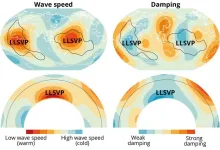(Press-News.org) HOUSTON ― The University of Texas MD Anderson Cancer Center’s Research Highlights showcases the latest breakthroughs in cancer care, research and prevention. These advances are made possible through seamless collaboration between MD Anderson’s world-leading clinicians and scientists, bringing discoveries from the lab to the clinic and back.
Novel allogeneic NK cell therapy from induced pluripotent stem cells shows encouraging efficacy in relapsed or refractory B-cell lymphoma patients
Patients with relapsed or refractory B-cell lymphomas have limited treatment options, although new immune and cell therapies are being developed. Natural killer (NK) cells derived from induced pluripotent stem cells (iPSC) or cord blood are a novel source for cancer cell therapies. In a new Phase I trial, Paolo Strati, M.D., and colleagues evaluated the safety and efficacy of FT596 – a novel allogenic iPSC-derived chimeric antigen receptor (CAR) NK cell therapy – as a monotherapy and in combination with rituximab in 86 patients with relapsed or refractory B-cell lymphomas. The cells were enhanced with three antitumor approaches, including a CD19-targeted CAR, a modified CD16 receptor and an interleukin-15 receptor fusion protein. According to this first-in-human trial, both regimens were well tolerated, and patients with both indolent and aggressive transformed B-cell lymphomas achieved deep and durable responses. Fewer than 15% of patients experienced low-grade cytokine release syndrome, and no neurotoxicity was observed, suggesting the cell therapy was safe for this patient population. Learn more in The Lancet.
Targeted therapies show responses in pretreated HER2-mutant metastatic breast cancer
The HER2 protein helps cells grow and divide, but it can lead to cancers in the breast, stomach and colon when it acts abnormally. While existing treatments target excessive HER2 activity, they haven’t been widely tested in cases with specific HER2 mutations. In a Phase II trial, Paula Pohlmann, M.D., Ph.D., and colleagues evaluated two HER2-targeted therapies, tucatinib and trastuzumab, in 31 women with advanced breast cancer. These women had metastatic HER2-negative breast cancer harboring specific HER2 mutations and had already undergone other treatments. The results showed that 42% of patients experienced tumor reduction with these targeted therapies. On average, their cancer remained controlled for about 9.5 months, with treatment benefits lasting around 12.6 months. These findings suggest tucatinib and trastuzumab may offer a treatment option for these patients and support further research to confirm their broader potential. Learn more in Nature Medicine.
Triplet combination is safe, shows promise for advanced clear cell renal cell carcinoma
The tyrosine kinase inhibitor (TKI) sitravatinib has shown antitumor responses and demonstrated an increase in effectiveness when used in combination with immune checkpoint inhibitors to treat patients with advanced clear cell renal cell carcinoma (ccRCC). In a Phase I trial, researchers led by Pavlos Msaouel, M.D., Ph.D., Linghua Wang M.D., Ph.D., and Jianjun Gao, M.D., Ph.D., examined the safety and efficacy of a triplet combination of sitravatinib, nivolumab and ipilimumab in 22 previously untreated patients with advanced ccRCC. The trial established a safe dose that resulted in a 45.5% objective response rate, an 86.4% disease control rate and a median progression-free survival of 14.5 months. Using single-cell RNA sequencing, the researchers also identified tumor cell-specific gene signatures that predicted treatment resistance and clinical outcomes. These results offer important insights to improve therapeutic strategies for patients with ccRCC. Learn more in Nature Communications.
Treatment efficacy for KRAS G12C-mutated lung cancer varies with co-mutations
Non-small cell lung cancers (NSCLCs) harboring KRAS G12C mutations are notoriously difficult to treat. While KRAS G12C inhibitors, such as adagrasib, have successfully targeted KRAS, many patients still experience a poor prognosis. Understanding the genomic differences present could improve treatment selection and identify new targets. In the Phase I/II KRYSTAL-I trial, Marcelo Negrao, M.D., and colleagues characterized the genomic features of 121 patients with KRAS G12C-mutant NSCLC treated with adagrasib. Overall, 32% of patients had longer survival with adagrasib monotherapy. High NRF2 signaling and/or the presence of KEAP1 and STK11 co-mutations were associated with shorter survival. The addition of an mTOR inhibitor improved treatment efficacy in lab models harboring KEAP1 and STK11 co-mutations, suggesting its therapeutic potential. The study highlights the importance of considering co-mutations and other genomic features in treatment selection to improve outcomes for patients with KRAS G12C-mutant NSCLC. Learn more in Clinical Cancer Research.
Combination therapy yields strong responses in patients with refractory lymphoma
Patients with refractory lymphomas, particularly those who did not benefit from chimeric antigen receptor (CAR) T cell therapy, do not respond well to subsequent treatments and face a poor prognosis. This highlights a need for more effective high-dose chemotherapy (HDC) combinations with autologous stem-cell transplantation. Preclinical studies showed marked synergy between the PARP inhibitor olaparib and HDC in refractory lymphoma in cell lines, leading Yago Nieto, M.D., Ph.D., and colleagues to evaluate the efficacy and safety of this combination in a Phase I trial. Among 50 adult patients, the overall and complete response rates were 100% and 90%, respectively. At a median follow-up of 30 months, the event-free survival (EFS) and overall survival (OS) rates were 72% and 82%, respectively. For 17 patients with prior CAR T cell therapy failure, the EFS and OS rates were 71% and 88%, respectively. These results suggest this combination is safe and promising for patients with refractory lymphomas. Learn more in Clinical Cancer Research.
Study finds novel biomarker, potential therapeutic target for renal medullary carcinoma
Renal medullary carcinoma (RMC) is a rare and aggressive kidney cancer involving the loss of the SMARCB1 tumor suppressor that mainly affects young individuals of African descent with the sickle cell trait. Patients with RMC have a poor prognosis and limited treatment options, and there is an unmet need for clinically relevant biomarkers for early detection. Researchers led by Pavlos Msaouel, M.D., Ph.D., used integrated profiling of primary untreated RMC tumor tissues and paired adjacent kidney controls to uncover potential biomarkers. They identified MUC16 – the gene encoding serum cancer antigen 125 (CA-125) – as one of the most significantly upregulated genes in RMC tumor tissues, correlating it to metastatic tumor burden. Further analysis of RMC cell lines revealed that SMARCB1 loss is necessary but not sufficient for MUC16 expression, explaining why elevated serum CA-125 levels are observed in most, but not all, RMC patients. The study suggests that serum CA-125 could serve as a clinical biomarker for RMC and highlights MUC16 as a potential therapeutic target. Learn more in Clinical Cancer Research.
Epigenetic pathway is involved in persistent inflammatory pain
Inflammation can sensitize neurons and lead to persistent pain. While studies have shown that this pain is associated with increases in expression of the TRPA1 and TRPV1 pain receptors, little is known about the underlying mechanisms driving this process. Researchers led by Hui-Lin Pan, M.D., Ph.D., and Krishna Ghosh, Ph.D., examined preclinical models of persistent inflammation to identify potential epigenetic pathways. They found the G9a enzyme is involved in modifying histones inside sensory neurons, which can control the accessibility of gene transcription regulatory elements. This increases access to and production of the TRPA1 and TRPV1 pain receptors, which then sensitize neurons and promote inflammatory pain. The study highlights the therapeutic potential of targeting G9a to reduce pain receptor activity and persistent inflammatory pain. Learn more in The Journal of Neuroscience.
Awards and Honors
Amma Asare, M.D., Ph.D., was named a 2024 Hanna Gray Fellow by the Howard Hughes Medical Institute
In case you missed it
Read below to catch up on recent MD Anderson press releases.
ExxonMobil donates $10 million to fund MD Anderson-led Be Well™ Beaumont initiative
Chances of quitting smoking improve with integrated care, including medication and counseling
Read this press release in the MD Anderson Newsroom.
END
MD Anderson Research Highlights for January 22, 2025
Featuring novel treatment strategies for lymphomas and kidney cancers, insights into inflammatory pain, and promising trial results for breast cancer and NSCLC
2025-01-22
ELSE PRESS RELEASES FROM THIS DATE:
Scholastica announces integration with Crossmark by Crossref to expand its research integrity support
2025-01-22
CHICAGO, IL (January 22, 2025) — Scholastica, a leading software solutions provider for academic journals, has released a new integration with Crossmark by Crossref, the industry standard mechanism for reporting updates to published research.
The Crossmark integration is now available to journals subscribed to the Scholastica Open Access Publishing Platform that are published by a Crossref member organization participating in the Crossmark service.
“Clearly communicating article updates and retractions is critical to maintaining the integrity of the scholarly record, and with this ...
Could brain aging be mom’s fault? The X chromosome factor
2025-01-22
Women are born with two X chromosomes and inherit one from each parent. But in every cell of their body, just one X chromosome is needed – so the other is randomly inactivated. Some cells use only a maternal X chromosome; others rely only on the paternal X.
Now, UC San Francisco researchers have found that when the brain cells of female mice express only a maternal X chromosome, their memory and cognitive skills deteriorate faster than female mice that express both maternal and paternal X chromosomes.
The discovery, which appears Jan. 22 in Nature, could explain the variation in brain aging between the sexes, since males inherit only a maternal X, as ...
Subterranean ‘islands’: strongholds in a potentially less turbulent world
2025-01-22
Deeply hidden in Earth’s mantle there are two huge ‘islands’ with the size of a continent. New research from Utrecht University shows that these regions are not only hotter than the surrounding graveyard of cold sunken tectonic plates, but also that they must be ancient: at least half a billion years old, perhaps even older. These observations contradict the idea of a well-mixed and fast flowing Earth’s mantle, a theory that is becoming more and more questioned. “There is less flow in Earth’s ...
Complete recombination map of the human-genome, a major step in genetics
2025-01-22
Complete recombination map of the human genome, a major step in genetics
Scientists at deCODE genetics/Amgen have constructed a complete map of how human DNA is mixed as it is passed down during reproduction. The map marks a major step in the understanding of genetic diversity and its impact on health and fertility. It continues 25 years of research at deCODE genetics into how new diversity is generated in the human genome, and its relationship to health and disease.
The new map, appearing today in the online edition of Nature, is the first to incorporate shorter-scale shuffling, ...
Fighting experience plays key role in brain chemical’s control of male aggression
2025-01-22
Like humans, mice will compete over territory and mates, and show increased confidence in their fighting skills the more they win. At first, a brain chemical called dopamine is essential for young males to master this behavior. But as they gain experience, the chemical grows less important in promoting aggression, a new study shows.
Dopamine has been linked to male aggression for decades. How past experiences might influence this relationship, however, had until now been unclear.
In experiments in rodents, a team led by researchers at NYU Langone Health boosted activity in dopamine-releasing cells in a part of the brain called the ventral tegmental area. The findings revealed that in ...
Trends in preventive aspirin use by atherosclerotic cardiovascular risk
2025-01-22
About The Study: Following landmark clinical trials and changes in guideline recommendations, self-reported primary prevention aspirin use decreased among older adults and adults with low atherosclerotic cardiovascular disease (ASCVD) risk for whom aspirin was not recommended, but also decreased among adults with higher ASCVD risk for whom aspirin may still be recommended. Despite these reductions, many patients with limited likelihood to benefit reported continuing to take aspirin.
Corresponding Author: To contact the ...
Sex differences in long COVID
2025-01-22
About The Study: This study found that female sex was associated with an increased risk of long COVID compared with male sex, and this association was age, pregnancy, and menopausal status dependent. These findings highlight the need to identify biological mechanisms contributing to sex specificity to facilitate risk stratification, targeted drug development, and improved management of long COVID.
Corresponding author: To contact the corresponding author, Dimpy P. Shah, M.D., Ph.D., email ShahDP@uthscsa.edu.
To ...
Medically recommended vs nonmedical cannabis use among US adults
2025-01-22
About The Study: The results of this study showed that adults ages 18 to 49 reporting medical-only or medical-nonmedical cannabis use vs nonmedical-only use had higher prevalence of cannabis use disorder at all severity levels and reported more frequent cannabis use. These findings suggest that medically recommended cannabis is not associated with reduced addiction risk compared with nonmedical use.
Corresponding author: To contact the corresponding author, Nora D. Volkow, M.D., email nvolkow@nida.nih.gov.
To access the embargoed study: ...
Spanish scientists discover how the gut modulates the development of inflammatory conditions
2025-01-22
A study led by David Sancho at the Centro Nacional de Investigaciones Cardiovasculares (CNIC) in Madrid reveals how an increase in intestinal permeability allows the natural gut bacteria to cross the intestinal barrier and reach the bone marrow, where they induce epigenetic changes—modifications that alter gene activity without affecting DNA sequence—in the stem cells that give rise to immune cells. The epigenetic changes induced by the translocated gut bacteria generate “trained” immune cells primed to respond more efficiently to future infections. However, this same ability to amplify the immune response can also aggravate the inflammatory conditions such as ...
Compact comb lights the way for next-gen photonics
2025-01-22
In the world of modern optics, frequency combs are invaluable tools. These devices act as rulers for measuring light, enabling breakthroughs in telecommunications, environmental monitoring, and even astrophysics. But building compact and efficient frequency combs has been a challenge—until now.
Electro-optic frequency combs, introduced in 1993, showed promise in generating optical combs through cascaded phase modulation but progress slowed down because of their high power demands and limited bandwidth. This led to the field being dominated by femtosecond lasers and Kerr soliton microcombs, which, while effective, require complex tuning and ...
LAST 30 PRESS RELEASES:
Electrodes created using light
Second-hand gift-giving is a well-deliberated decision
How human interaction drove evolution to make bears less aggressive
National Poll: Few parents offer teens guidance on healthy eating during holiday season
Cannabis derivatives could provide new ovarian cancer treatments
Raising strong yeast as a petroleum substitute
Clues to the origin of hot Jupiters hidden in their orbits
Canada’s reduced pledge to Global Fund will impact domestic health
1 in 4 children with major traumatic injuries not cared for in pediatric trauma centres
Duke and Duke-NUS’ joint cross-population research to uncover "East-West" differences in disease and care
Scientists to ‘spy’ on cancer- immune cell interactions using quantum technology breakthrough
Tech savvy users have most digital concerns
Making lighter work of calculating fluid and heat flow
Normalizing blood sugar can halve heart attack risk
Lowering blood sugar cuts heart attack risk in people with prediabetes
Study links genetic variants to risk of blinding eye disease in premature infants
Non-opioid ‘pain sponge’ therapy halts cartilage degeneration and relieves chronic pain
AI can pick up cultural values by mimicking how kids learn
China’s ecological redlines offer fast track to 30 x 30 global conservation goal
Invisible indoor threats: emerging household contaminants and their growing risks to human health
Adding antibody treatment to chemo boosts outcomes for children with rare cancer
Germline pathogenic variants among women without a history of breast cancer
Tanning beds triple melanoma risk, potentially causing broad DNA damage
Unique bond identified as key to viral infection speed
Indoor tanning makes youthful skin much older on a genetic level
Mouse model sheds new light on the causes and potential solutions to human GI problems linked to muscular dystrophy
The Journal of Nuclear Medicine ahead-of-print tip sheet: December 12, 2025
Smarter tools for peering into the microscopic world
Applications open for funding to conduct research in the Kinsey Institute archives
Global measure underestimates the severity of food insecurity
[Press-News.org] MD Anderson Research Highlights for January 22, 2025Featuring novel treatment strategies for lymphomas and kidney cancers, insights into inflammatory pain, and promising trial results for breast cancer and NSCLC




